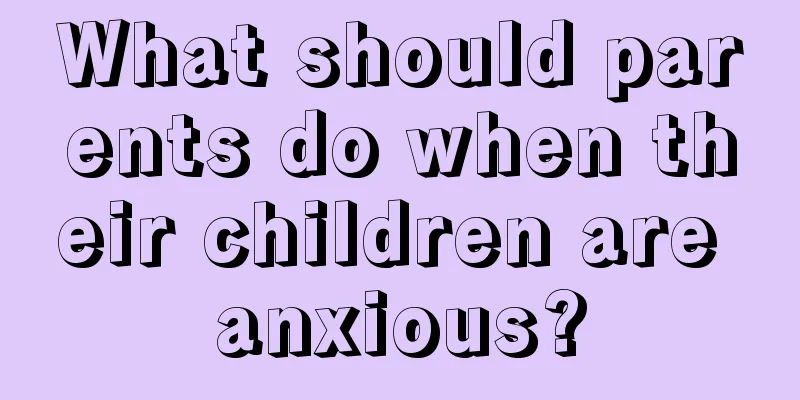Causes of moderate anemia in infants and young children

|
Most of the anemia in babies is related to the unreasonable nutrition of children. Children are always not full when they eat, and the food is not nutritious when they are full. Children's anemia can be divided into three degrees: mild, moderate, and severe. Moderate anemia in children is considered normal. So what are the causes of moderate anemia in infants and young children? For infants under one year old, hemoglobin below 11 grams is considered anemia; for children over one year old, hemoglobin below 11.5 grams is considered anemia. However, infants will experience an unstable period of decreased hemoglobin between 6-10 months. If the child does not show symptoms such as lethargy, decreased appetite, restless sleep, pale complexion and nails, he or she must not be diagnosed with anemia. As the baby gets older, the body's erythropoietin production increases, the bone marrow hematopoietic function gradually recovers, the number of red blood cells and hemoglobin slowly increases, and anemia is alleviated. To determine whether the patient has iron deficiency anemia, venous blood should be drawn to test the iron content in the blood. The most common anemia in children is iron deficiency anemia. This is because: (l) Children are born with insufficient iron storage. The iron that a normal full-term newborn obtains from the mother is sufficient for its hematopoietic needs for 3 to 4 months after birth. However, premature birth, twins, fetal blood loss and maternal iron deficiency anemia can all lead to insufficient iron storage in children. (2) Insufficient iron intake. The diet of newborns mainly consists of human milk or cow's milk, and the iron content in both human milk and cow's milk is low. If they are fed only with milk without adding iron-rich complementary foods in time, anemia is likely to occur. (3) Growth and development decisions. Growth and development are rapid during infancy. At 3 to 5 months, the baby's weight is twice that of his birth weight, and at 1 year old, it is three times his birth weight. If the baby is premature, the weight gain is faster. As body weight increases, blood volume also increases rapidly, making iron deficiency more likely to occur, leading to anemia. (4) Excessive iron loss. Normal infants excrete more iron every day than adults, and lose relatively more iron through the skin. If they are allergic to protein and have small intestinal bleeding, they lose even more iron. In addition, some diseases such as chronic diarrhea, intussusception, intestinal polyps, etc. can increase iron consumption and cause anemia. If iron deficiency anemia is confirmed, the mother should supplement the baby with iron if the baby is breastfed. Don't blindly believe in iron-fortified milk powder or rice noodles, because the iron in most foods is highly sticky and cannot be absorbed by the human body. Although there is little iron in breast milk, it is enough to meet the needs of the baby, and it is active iron with a very high absorption rate. The absorption rate of iron in breast milk (50-75%) is much higher than that of iron-fortified milk powder (only 4%), and milk will cause the iron in the child's body to be lost through feces. In other words, children who are breastfed generally do not suffer from anemia, but are likely to suffer from iron deficiency when they eat milk powder. Children's nutrition should be supplemented through diet, and medications should not be used without clear indications, as this will easily cause more problems. Unless the baby's anemia is particularly severe, it is necessary to use medication to supplement iron under the guidance of a doctor. The above introduces the various causes of anemia in children. These causes must be reasonably adjusted for the children. Knowing the cause of the child's anemia, we must treat the child in time in this way. The cause of the child's anemia is also worthy of our serious attention and improvement. We must give the child more foods rich in iron, and the child's nutrition must also keep up to avoid the child's picky eating habits. |
<<: How to determine whether your child is zinc deficient
>>: What are the clinical manifestations of heart failure in infants and young children?
Recommend
What to do if your child's teeth are corroded
A child is a new baby to his parents, and any pro...
Baby's self-awareness sensitive period
Babies will have a sensitive period of self-aware...
Treatment of neonatal hip dislocation
There are many common diseases in newborns. Newbo...
Symptoms of lead poisoning in children
Children are the most innocent creatures in the w...
The dangers of precocious puberty in children
Children's height development is related to h...
What to do if your baby has pyloric stenosis
What should I do if my baby has pyloric stenosis?...
Treatment of mumps in children
Mumps is not only a disease that adults are prone...
How to check for tuberculosis in children
Tuberculosis is known as the second largest infec...
Breast milk jaundice has not subsided after 5 months
Many babies experience jaundice after birth. This...
Baby care tips for new mothers
Whenever a new life comes, what follows is not on...
Is it okay to use enema for children?
Dry stools in babies are a common phenomenon in o...
What to do if a baby girl has hernia
The hernia we usually talk about refers to congen...
What should I do if my child is covered with prickly heat?
Prickly heat is a skin disease that occurs in hum...
Treatment for children with a temperature below 36 degrees
Nowadays, infant diseases are rampant and many in...
What to do if middle school students often lose their hair
Many middle school students are under great acade...









